PLANETARY
NEBULAE: DEATH THROES OF SUN LIKE STARS
Planetary
Nebulae are some of the prettiest objects we can see in a
dark
night even in a backyard telescope. They show us the endgame of
life
for a typical star and also forecast the fate of our Sun and
solar
system. Finally they start gaining the recognition they deserve
as
some of the most revealing and useful objects in the universe
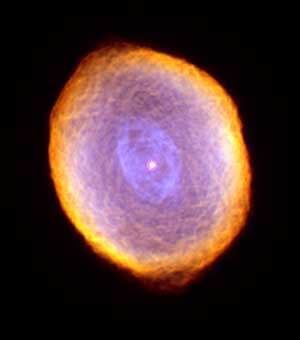
Glowing like a multi-faceted jewel, the planetary nebula
IC 418
lies about 2,000 light-years from Earth in the constellation Lepus.
(HST image)
Despite
the name, these objects have nothing in common with ``planets''.
They do
however represent the likely final episode of solar type stars.
A
star is born, lives, grows old and dies.
Most of its
lifetime a star shines by burning hydrogen into helium in its centre.
A star starts to die when it has exhausted the nuclear
fuel in its
core. Its longevity depends upon its mass: the heavier the star, the sooner
it dies. Massive stars die very violently in a
bright explosion,
called a supernova. The vast majority of stars, like our sun or up
to eight times heavier, die more gracefully, more
slowly.
After exhausting its thermonuclear fuel supply in the core, the outer layers
fall inward. On their way in they ignite,
causing the
outer material to be flung outward in an expanding cloud of gas.
When only a bit of hydrogen is left over the core
the whole
shell will be ejected. When the remnant stellar core has become hot
enough, this nebula will glow from the radiation of
this exposed
hot core. It is visible as a planetary nebula. The remnant core will emerge
through the expanding veil of ejected material as
a white dwarf.
A white dwarf is very dense. It has half the mass of the Sun, but is only
the size of the Earth. The white dwarf, will
The white
dwarf, will very slowly fade away and over several billions of years turn
into a dark and invisible briquette, floating lifeless
in the vast
graveyard of space. Continued expansion of the nebula at an average velocity
of 90,000 km/h, combined with the decreasing
radiation
of the cooling white dwarf causes the brightness of the nebula to decrease
rapidly. After roughly 25,000 years from its first
appearance,
the nebula would disappear from view. It eventually disperses into
the interstellar medium, enriching it with carbon, nitrogen
and oxygen,
that were produced in the stellar interior. This material can be recycled
to form other stars and planets, and eventually life.
You are made
of star stuff, we all are. The atoms of some of the elements that comprise
our bodies were created in the depth of the
stars. What
we are is literally stuff of the cosmos - atoms that have been recycled
many times before they came together to make you.
These pictures
illustrate the different ways in which dying stars eject their outer layers
as highly structured nebulae.
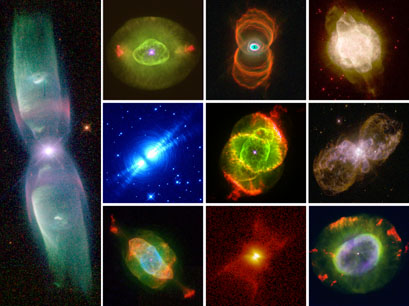
A
montage of pre- and true planetary nebulae made with the Hubble Space
Telescope
Credits: Bruce
Balick, Howard Bond, Raghvendra Sahai, their collaborators, and NASA
From left to right:
M2-9, NGC
6826, Hourglass Nebula, NGC 3918, Egg Nebula, Cat's Eye Nebula, Hubble
5, NGC 7009, Red Rectangle, NGC 7662.
Their beauty
is matched by the mystery.
The basic
question is: how do these nebulae shape themselves ?
A most intriguing
challenge is to understand how stars transform their surrounding
large
spherical
mass-loss shells in a couple of thousand years into the variety of shapes
and sizes observed in planetary nebulae.
There are
a number of theories currently being investigated. No consensus about
the dominant physical process
responsible
for the shaping of planetary nebulae has emerged so far, but there is agreement
that the shaping occurs during
or soon after
the star ejects the nebula and the object is on its way of becoming a planetary
nebula.
The details
of the rate of evolution and the strength of the stellar wind during this
transition phase are essential ingredients
in understanding
the shaping of the planetary nebulae. However, both are very poorly known,
either theoretically or observationally.
To remedy
this Dr Griet Van de Steene in collaboration with Dr Peter Wood from the
Australian National University,
and Dr Peter
van Hoof from the Canadian Institute of Theoretical Astrophysics are studying
a sample of IR-selected stars
which are
becoming planetary nebulae.
Images
and spectra provide us with information about what has happened during
the star's life and how it dies.
 The Ring Nebula (M57) - HST picture
The Ring Nebula (M57) - HST picture
The nebula is about a light-year in diameter and is located some
2,000 light-years from Earth in the direction of the constellation Lyra.
The colors are approximately true colors. The color image was assembled
from three black-and-white photos taken through different color filters
with the Hubble telescope's Wide Field Planetary Camera 2. Blue isolates
emission from very hot helium, which is located primarily close to the
hot central star. Green represents ionized oxygen, which is located farther
from the star. Red shows ionized nitrogen, which is radiated from the coolest
gas, located farthest from the star. The gradations of color illustrate
how the gas glows because it is bathed in ultraviolet radiation from the
remnant central star, whose surface temperature is a white-hot 216,000
degrees Fahrenheit (120,000 degrees Celcius)
A typical spectrum
of a planetary nebula, contains several emission lines. The properties
of a planetary nebula
(stellar temperature
and luminosity, and chemical composition of the nebula) can be determined
using the observed
spectrum.
The influence of the nebular structure on the determination of the abundances
remains an issue.
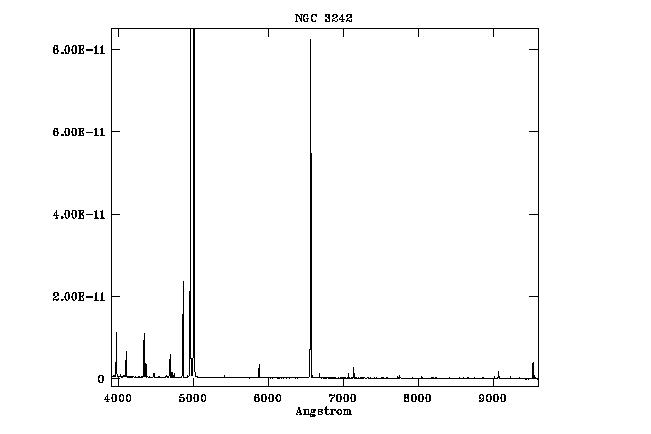
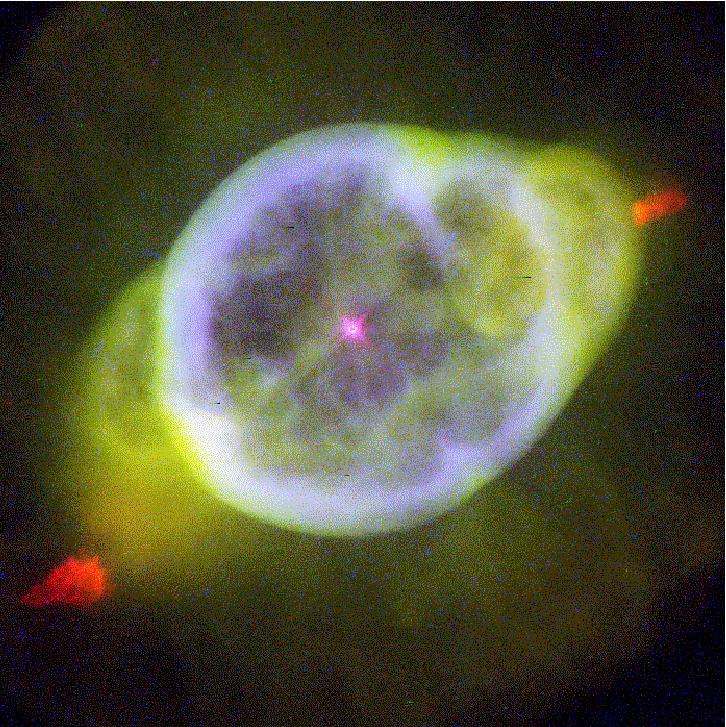
Spectrum
of NGC 3242 obtained with the 1.52-m telescope and the Boller \&
Chivens spectrograph
at La Silla
Observatory of the European Southern Observatory by Griet Van de Steene.
Picture By Bruce Balick.
Dr Griet Van de
Steene in collaboration with Dr Peter van Hoof worked on photo-ionization
modelling in order to determine
the chemical
composition of planetary nebulae.
Planetary
Nebulae are observable in far away galaxies
The spectra
of planetary nebulae include several bright emission lines, which make
them detectable and
recognisable
over large distances, not only in the obscured regions close to the center
of our own galaxy,
but even in
external galaxies, such as the Andromeda galaxy, and as far away as the
Virgo Cluster.
Dr. George
Jacoby from the National Optical Astronomical Observatories in the USA
and Dr. Griet Van de Steene
have identified
95 new candidate planetary nebulae close to the center of our Galaxy.
They have
obtained follow-up spectra for ~65 of these to confirm all but a couple
as bona fide nebulae.
These observations
of the Galactic center nebulae will help define the motions of stars
in the central
"bar" of our Galaxy, as well as flagging any nebulae that originated in
the halo of our Galaxy but are
presently
passing near the Galactic nucleus; already, two very fast moving candidates
have been identified as
possible halo
visitors. Thus far, only ~12 of the new ~90 planetary nebulae in the Galactic
center have been analyzed to derive
their chemical
compositions. The chemical compositions appear to be similar to those found
in the Andromeda galaxy by
Jacoby and
Ciardullo. In most of the remaining cases, it will not be possible to make
the measurements because
the nebulae
are extremely faint, being extinguished by an enormous of dust between
the Galactic center
and the Earth.
Thus, each nebula that can be studied is an important one. We are continuing
our analysis of the existing spectra.
Planetary Nebulae
can be observed out to large distances from the core of galaxies. The measurement
of their velocities
provides the
only way to study the dynamics and the distribution of dark matter in the
halos of elliptical galaxies.
Planetary Nebulae
are used as candlesticks to measure distances to other galaxies and in
this way contribute
to unravelling
the fate of the Universe.
The chemical
composition of a planetary nebula is determined by the chemical composition
in the cloud of gas from which
the progenitor
star was formed and by the modification of these abundances by the nuclear
reactions during the star's life.
Hence planetary
nebulae contribute to determining the chemical evolution of galaxies.
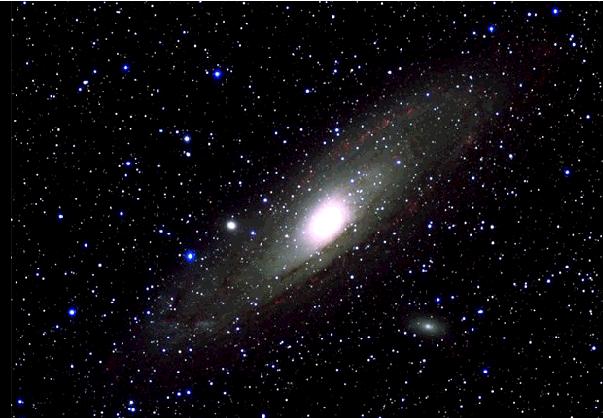
MSSSO image of the Andromeda Galaxy (M31). At a distance of 2900
kly, this spiral galaxy is our nearest large neighbour within the Local
Group.
The image was obtained with the 16 inch telescope and Nikkor 400mm
f/4.5 lens at SSO by the Imaging Team.
There seem to be several times more halo planetary nebulae in M31 than
in our own Galaxy.
Jacoby and collaborators have accumulated velocities for over 800 nebulae
in the nearby Andromeda galaxy.
They have measured the chemical compositions of 15 planetary nebulae
in M31. From these measurements, it is clear that
the stars in M31 are derived from a complex history of chemical
enrichment because they span a very wide range of compositions,
from 20 times lower than the Sun to just slightly higher than
the Sun.


 The Ring Nebula (M57) - HST picture
The Ring Nebula (M57) - HST picture

